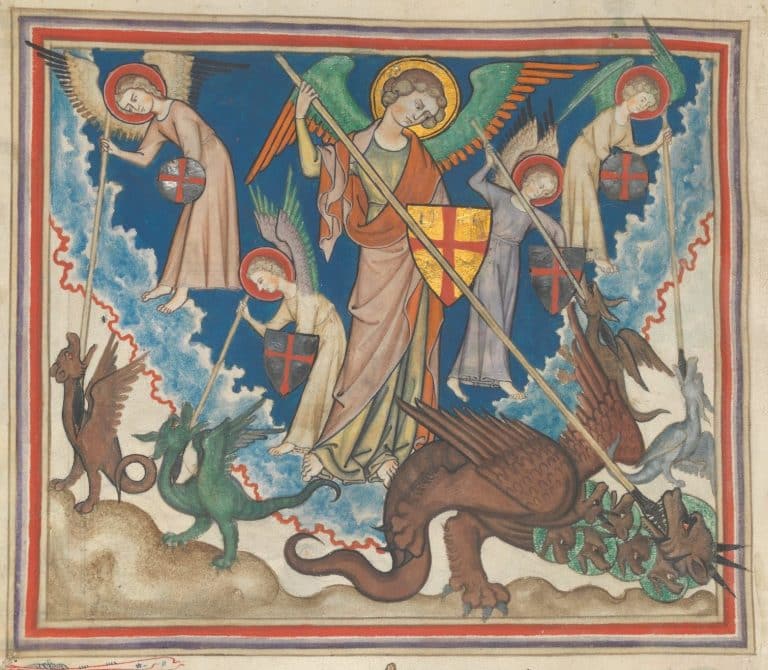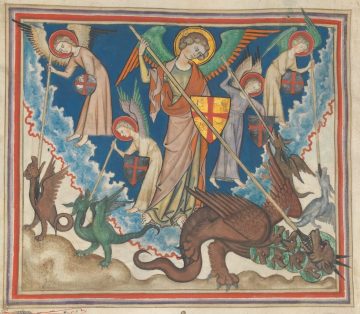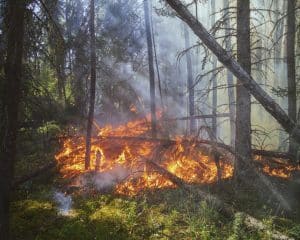I teach youth Sunday School, and my particular group of youth are nerdy and artistic. We’re going to spend most of the this class period creating a graphic novel fan fiction version of the assigned chapters. I’m going to bring several large pieces of paper and lots of markers and colored pencils. We might move class to the gym so there’s plenty of space to work. I’ll label the top of each paper so students get a choice about what they want to draw.
- Chapter 6, Six seals: four horses, martyrs, earthquake
- Chapter 7, Angels, tribes, multitude
- Chapter 8, 7th seal: silence, then trumpets 1-4
- Chapter 9, First two woes: battle locusts, cavalry
- Chapter 10, John eats a little book
- Chapter 11, Measuring the temple, two witnesses, 7th trumpet
- Chapter 12, woman, child, and dragon
- Chapter 13, beast from the sea, beast from the earth
- Chapter 14, the Lamb on Mt. Zion, angels reap
Ask the class what they know about the book of Revelation. Ask if they remember from chapters 1-5. (There are a couple helpful summaries on Wikipedia: this one is in outline form, and this one goes chapter by chapter). Talk about how the book of Revelation is filled with symbolic imagery. Tell the class that in chapter 5 there is a scroll sealed with seven seals and only the “Lion of the tribe of Judah” can open the seals. The Lamb takes the scroll and begins to open the seals.
Explain that to learn about what happens next, we’ll be creating a graphic novel adaptation of the next few chapters. Discuss the format of a graphic novel: illustrations tell the story, dialogue bubbles, a few captions to help explain the narrative.
Assign each class member a chapter to read and illustrate. They can work in groups. If there are less than nine people to illustrate, assign the first chapters and anyone who finishes early can work on the later chapters. Chapter 10 is the shortest, if there are any reluctant illustrators. Explain that most of the class period will be spent working on illustrating the chapters, and the last 15-20 minutes of class will be spent sharing what we create.
Going in chapter order, have each student/group show their work to the class. As students share, ask if they have any guesses about what any of the symbols mean. Some points about symbols you might discuss:
- Talk about biblical numerology and that numbers in the bible are often associated with meanings beyond their numerical value.
- Some symbols can be confusing, but it’s okay if we don’t know what all of them mean. There are lots of laundry symbols, and I can’t remember what all of them mean, but I can still do laundry and most of the time my clothes come out okay. When I have something special that needs to be washed, then I will take the time to learn how to take care of it. The same goes with spiritual things: if you need more knowledge, you can seek for it.
- The meaning of a symbol can change depending on the context. If you see a triangle on a fabric tag, that means you can use bleach. If you see a triangle on a map, it might mean a mountain.
When a little child draws a picture, I don’t always understand what it is that they drew. When they tell me what it represents, the picture suddenly makes sense and I can see what they were trying to communicate. With the book of Revelation, we can’t ask John what he meant. We can get ideas from others who have studied the book, and we can also ask God to help us understand. Joseph Smith asked God questions about the book of Revelation and that gave us Section 77 of the Doctrine and Covenants, but there are lots more questions that could be asked. Part of what makes life exciting is that we don’t have all the answers and we don’t understand everything yet. God has given you the capacity to learn what is necessary for you to learn.






3 Responses
This is fabulous! I teach Gospel Doctrine — and I really wish I had the nerve to do this.
You totally can use this in Gospel Doctrine! Set up tables and chairs to color at. Maybe lead with the story about trying to interpret a young child’s drawing and jokingly remind everyone that Jesus said we are to become like little children.
The drawing activity is less about artistic talent and more about transforming text symbols into visual symbols. It can also be a lesson in how much thought it takes to communicate symbolically.
This sounds so engaging! Your class is lucky.